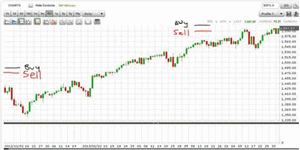A lot of traders have been increasingly uneasy about the market's steady climb, so options trader Laurie Itkin of TheOptionsLady.com, offers a way to profit and still sleep at night.
The major market indexes continue to grind higher month after month. Minor pullbacks occur but gains erase them. Some investors are afraid to continue putting money into long positions. So what can you do to profit from market highs?
Consider layering weekly bear call spreads on SPY, SPX, IWM, or RUT. I prefer trading the index options (i.e. SPX, RUT, NDX) because of their tax treatment. Whether I hold the trade for two years or two minutes, 60% of my gains are taxed at long-term capital gains rates, and only 40% at ordinary income rates. The tax treatment is irrelevant in an IRA so folks trading in their retirement accounts would do better by trading the SPY and IWM as the bid/ask prices are narrower.
Here's the strategy using SPX as an example:
Each time the SPX hits a new high or close to a previous high, consider selling an out-of-the-money bear call spread. If the SPX is trading at 1590, for example, you could sell the 1610 call and buy the 1620 for protection. You control your risk/return ratio. For a higher probability trade with a lower potential return, sell a call option farther away. For a lower probability trade with a higher potential return, sell a call option closer to the current trading price.
To generate consistent cash flow while adapting to the changing market, consider layering trades with different weekly expirations.
To help reduce the margin requirement, you can also sell bull put spreads on the other side. This creates what is called an iron condor.This strategy is not for newbies or those who can't stand to view large daily fluctuations in their account value. Learning risk management techniques, such as when to close or roll the position to a later date, are essential. Take advantage of short-term drops in the market, such as what occurred the day of the Boston bombings, in order to close your position and take your gains.
Disclosure: This article should not be construed as advice to buy or sell any security. It is intended to educate readers about a particular options trading strategy.
By Laurie Itkin, Founder, TheOptionsLady.com


















